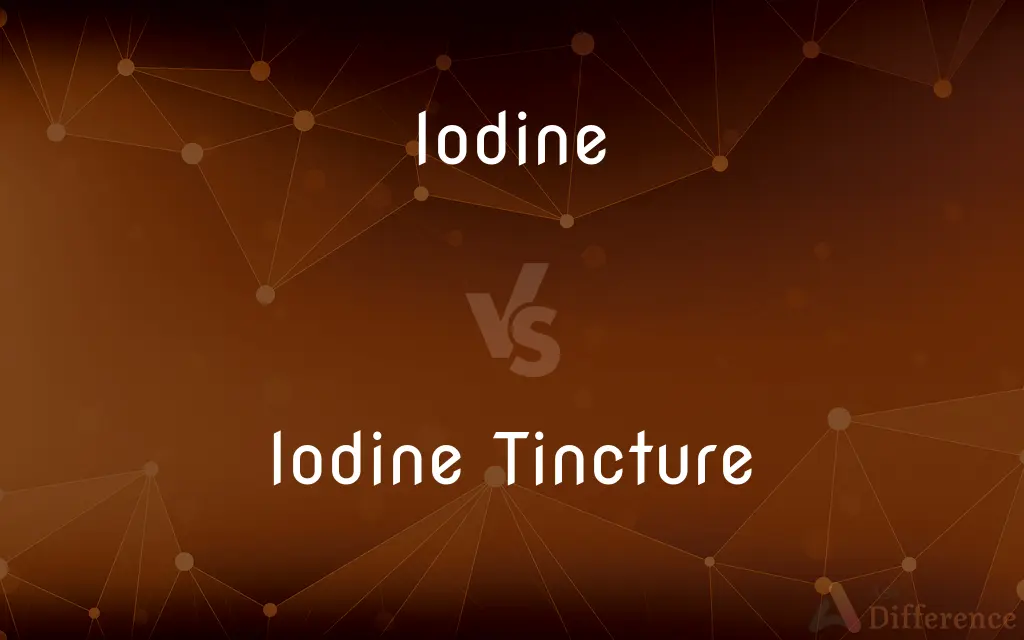Iodine vs. Iodine Tincture — What's the Difference?
By Tayyaba Rehman — Published on December 19, 2023
Iodine is a chemical element; Iodine Tincture is a solution of iodine dissolved in alcohol and water, often used as a disinfectant.

Difference Between Iodine and Iodine Tincture
Table of Contents
ADVERTISEMENT
Key Differences
Iodine is a halogen, a chemical element with the symbol "I" and atomic number 53. It's a lustrous, purple-black, non-metallic solid at room temperature and is essential for human health. Iodine Tincture, on the other hand, is a specific preparation made by dissolving iodine in a mixture of alcohol and water.
While Iodine in its elemental form has a range of uses, from nutrition to photography, it can be harmful if directly applied to the skin or consumed in large quantities. Iodine Tincture is specifically formulated for topical application, leveraging iodine's antiseptic properties for treating minor wounds and cuts.
The inherent properties of Iodine, such as its ability to form compounds with many elements and its radiocontrast abilities, make it useful in various industries and medical practices. Iodine Tincture's primary role is in the realm of first aid, where it disinfects and aids in the prevention of infections.
Pure Iodine can be volatile, sublimating into a purple-violet vapor if heated slightly. In contrast, Iodine Tincture is stable, thanks to the alcohol content, making it safe for storage and use over time.
For nutritional purposes, Iodine is crucial, as it's a key component of thyroid hormones, which regulate metabolic activities. Iodine Tincture, while containing iodine, is not meant for internal consumption and is strictly an external antiseptic.
ADVERTISEMENT
Comparison Chart
Composition
Pure chemical element.
Solution of iodine in alcohol and water.
Primary Use
Essential nutrient, industrial uses.
Topical antiseptic for wounds.
Form
Lustrous, purple-black non-metallic solid.
Liquid solution, often amber in color.
Consumption Safety
Necessary in trace amounts for health; toxic in large amounts.
Not for internal consumption.
Volatility
Can sublimate into purple-violet vapor when heated.
Stable due to alcohol content.
Compare with Definitions
Iodine
A chemical element with the symbol "I" and atomic number 53.
Iodine is an essential element for thyroid function.
Iodine Tincture
Beneficial for disinfecting minor cuts and abrasions.
After scraping my knee, I reached for the Iodine Tincture.
Iodine
An essential nutrient required for thyroid hormone production.
A deficiency in Iodine can lead to goiter.
Iodine Tincture
Used as a topical antiseptic.
Before stitching, the nurse cleaned the cut with Iodine Tincture.
Iodine
A lustrous, purple-black non-metallic solid at room temperature.
When heated, Iodine gives off a distinct purple vapor.
Iodine Tincture
A solution of iodine in alcohol and water.
I applied Iodine Tincture to disinfect the wound.
Iodine
Used in various industries, including photography and medicine.
Iodine-based contrast agents are used in radiology.
Iodine Tincture
Combines the antiseptic properties of iodine with the solvent properties of alcohol.
The Iodine Tincture provided both disinfection and a cooling sensation.
Iodine
Symbol I A lustrous, purple-black, corrosive, poisonous halogen occurring as a diatomic molecule, I2, that easily sublimes to give a purple gas and is a trace element essential for proper thyroid function. Radioactive isotopes, especially I-131, are used as medical tracers and in thyroid disease diagnosis and therapy. Iodine compounds are used as germicides, antiseptics, and dyes. Atomic number 53; atomic weight 126.9045; melting point 113.7°C; boiling point 184.4°C; density of gas 11.27 grams per liter; specific gravity (solid, at 20°C) 4.93; valence 1, 3, 5, 7. See Periodic Table.
Iodine Tincture
Often amber in color and liquid in form.
The amber-colored bottle contained Iodine Tincture.
Iodine
An antiseptic preparation containing iodine in solution, used to treat wounds.
Iodine
A chemical element (symbol: I) with an atomic number of 53; one of the halogens.
Iodine
An antiseptic incorporating the element.
Iodine
An iodide.
Iodine
(transitive) to treat with iodine.
Iodine
A nonmetallic element, of the halogen group of atomic number 53, occurring always in combination, as in the iodides. When isolated it is in the form of dark gray metallic scales, resembling plumbago, soft but brittle, and emitting a chlorinelike odor. Symbol I. Atomic weight 126.90. If heated, iodine volatilizes in beautiful violet vapors.
Iodine
A nonmetallic element belonging to the halogens; used especially in medicine and photography and in dyes; occurs naturally only in combination in small quantities (as in sea water or rocks)
Iodine
A tincture consisting of a solution of iodine in ethyl alcohol; applied topically to wounds as an antiseptic
Iodine
Can form compounds with many elements.
When Iodine reacts with starch, it turns a blue-black color.
Common Curiosities
Can I consume Iodine directly?
While iodine is essential in trace amounts, direct consumption in large quantities can be toxic.
Is Iodine Tincture safe to drink?
No, Iodine Tincture is meant for external use only.
Why is Iodine important for humans?
Iodine is crucial for thyroid hormone production, which regulates metabolic activities.
How does Iodine appear in its natural state?
Iodine is a lustrous, purple-black non-metallic solid at room temperature.
How is Iodine Tincture different from pure Iodine?
Iodine Tincture is a solution of iodine in alcohol and water, formulated for topical use.
Can I use Iodine Tincture for any wound?
Iodine Tincture is suitable for minor cuts and abrasions; for deep wounds, consult a healthcare professional.
What is Iodine in its basic form?
Iodine is a chemical element, a purple-black non-metallic solid.
Is it safe to apply pure Iodine on the skin?
Pure Iodine can be harmful and irritating to the skin; it's better to use formulations like Iodine Tincture.
What makes Iodine Tincture stable for storage?
The alcohol content in Iodine Tincture adds stability, preventing rapid sublimation.
What is the primary use of Iodine Tincture?
Iodine Tincture is primarily used as a topical antiseptic for wounds.
Are there any other uses for Iodine besides nutrition?
Yes, Iodine has various industrial uses, including in photography and medicine as a contrast agent.
What gives Iodine Tincture its distinct color?
The presence of iodine in the solution gives Iodine Tincture its typical amber color.
Share Your Discovery

Previous Comparison
Specific Gravity vs. Specific Weight
Next Comparison
Avoidable Cost vs. Unavoidable CostAuthor Spotlight
Written by
Tayyaba RehmanTayyaba Rehman is a distinguished writer, currently serving as a primary contributor to askdifference.com. As a researcher in semantics and etymology, Tayyaba's passion for the complexity of languages and their distinctions has found a perfect home on the platform. Tayyaba delves into the intricacies of language, distinguishing between commonly confused words and phrases, thereby providing clarity for readers worldwide.













































